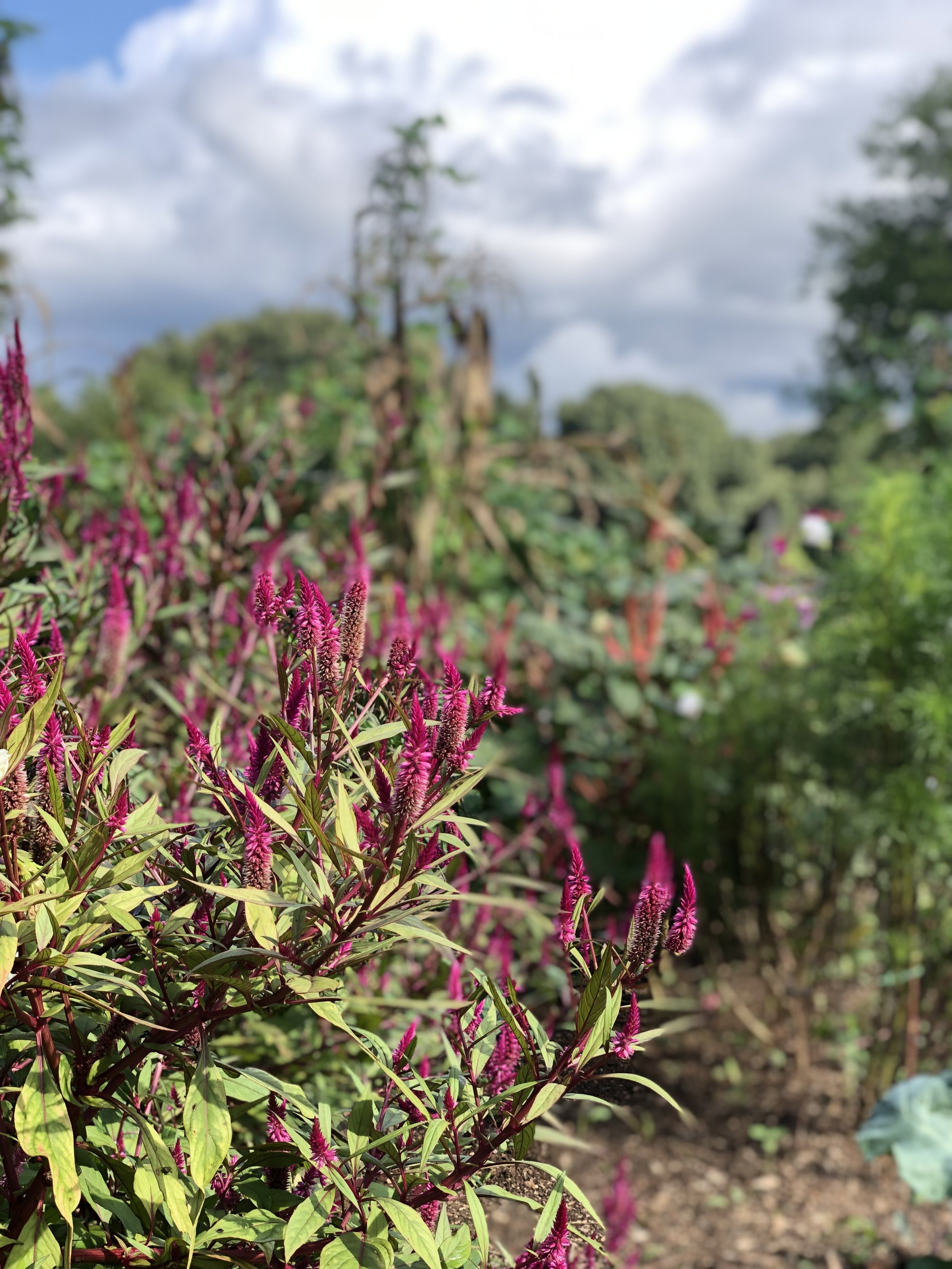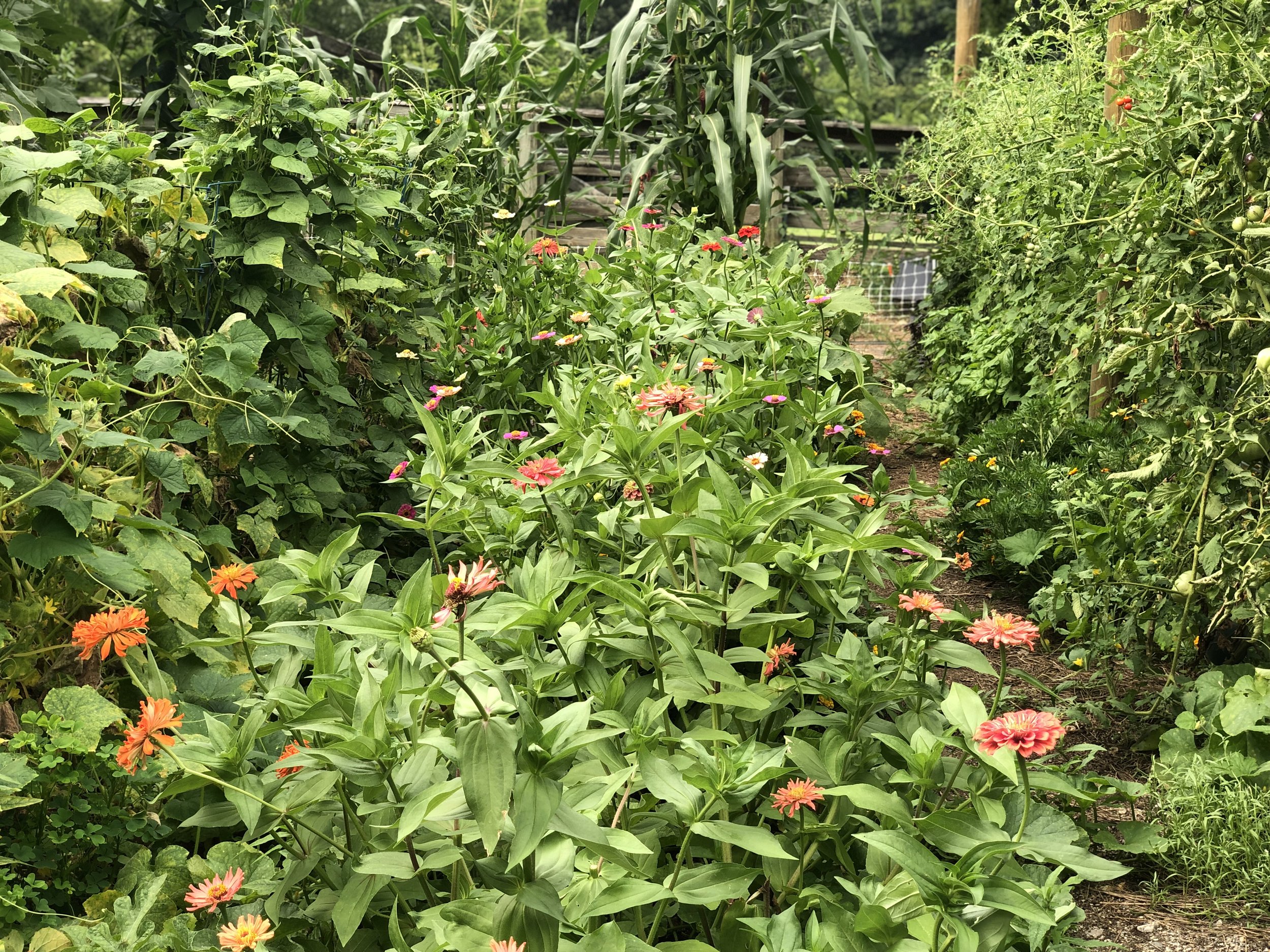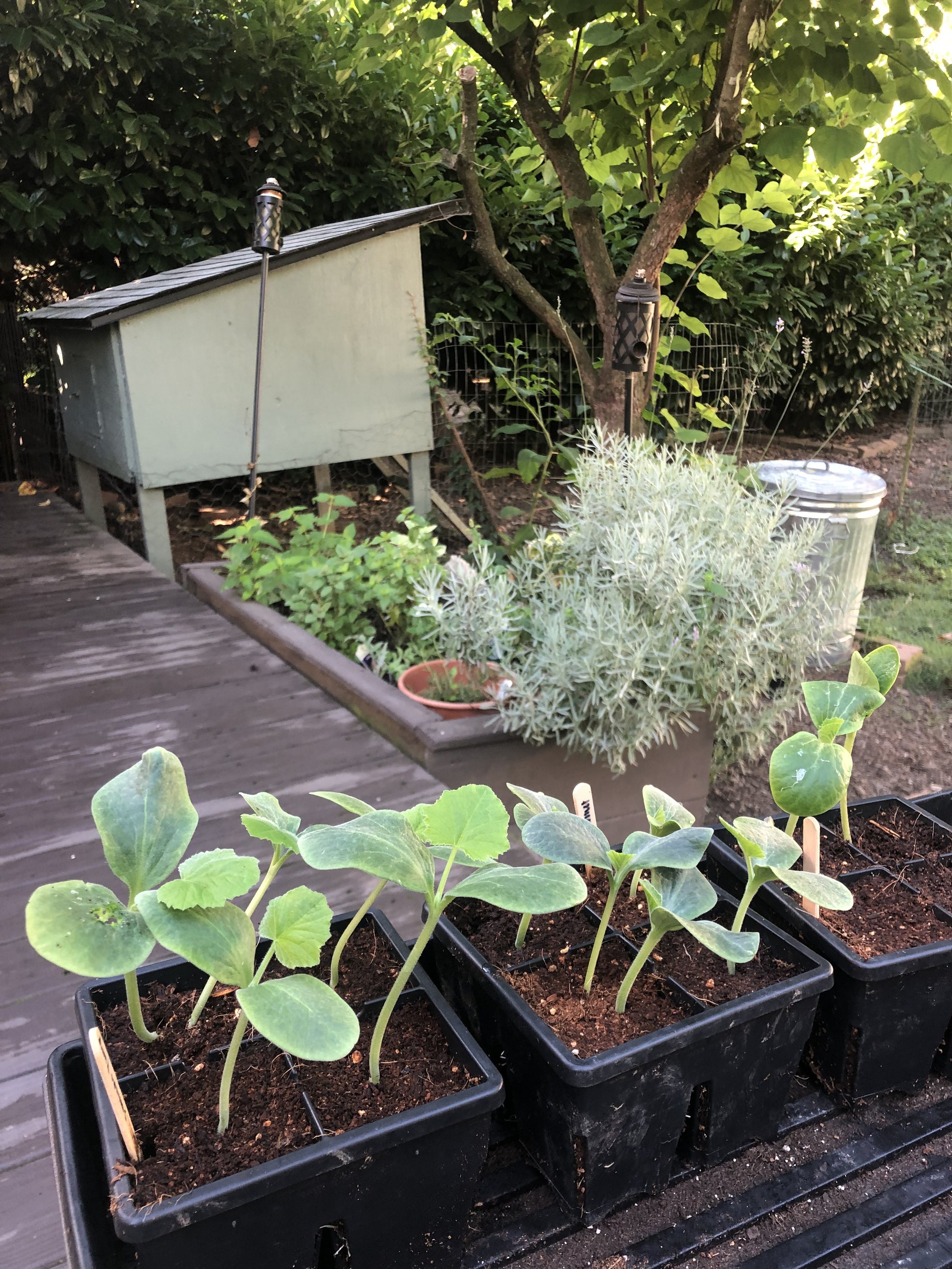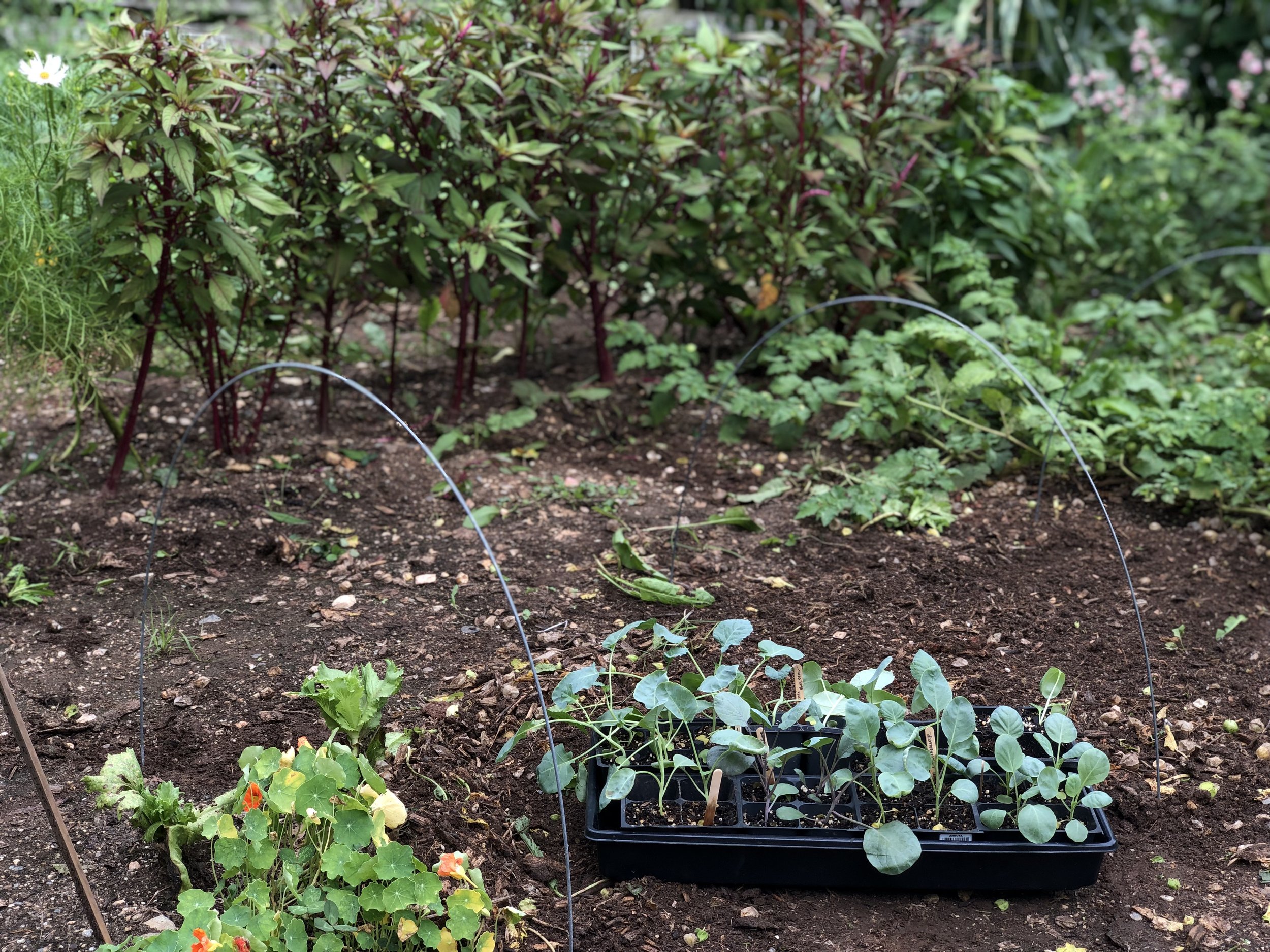I’m continuing my very delayed recap of the last growing season—trying to remember all the disparate lessons from failed experiments and useful changes I made this past year.
New projects in Summer 2022:
Cucamelon vines
Ground cherries
Sweet corn
Greatly expanded flower variety
Fiddling with winter squash planting times
Previewing a whole new growing space
Chard (and especially “Perpetual Spinach” variety) was a cornerstone of early summer before the larger tomatoes and big harvest of green beans got going. I had had bug damage early on with the chard, but once I thinned out almost a 2/3 of the plants, there was less hiding space in there for grasshoppers/crickets and I think the birds took care of that problem.
One game-changing backbone to my growing year was my monthly volunteer days at Shalom Farms where I learned a tremendous amount about harvesting leafy greens (for example, banding them in bunches in the field before washing like the picture above), pruning vining crops like cucumbers, and keeping hot weather crops healthy and producing (like “flushing” pepper plants to keep fruit from growing in the center where it will grow and break the main stem)
Naturally the cherry tomatoes started giving us great handfuls before we had any larger sandwich-sized slicer tomatoes ripe. I really loved growing the Arkansas Little Leaf cucumber again this year. First pepper to produce for us was a Cubanelle plant I had bought at southern states which makes me think I had started my own pepper plants too late last year (even though I started by Valentine’s Day!) if I want peppers in late June.
My cucamelons grew like never before. I put in 10 plants at the end of May to share the backside of the same trellis as most of our tomatoes- which worked great at first.
Soon, though, the cucamelon vines outgrew the tomatoes and I think keep the tomatoes from getting as much air flow as they needed (started seeing diseased leaves on the tomatoes!).
In the first week of August, I ripped out this many of the cucamelon vines in favor of letting the tomatoes take priority. Definitely could have done that sooner. I left just 2 or 3 cucamelon plants, which was enough for us, since we had been eating loads of cucamelons since mid July.
Back under control (see the difference on that front pole that the vines had overtaken)
Ground cherries were another fun surprise! I put in 3 plants total and we got a lot of them (even still have some in the freezer waiting to be made into pie!). Good thing they were yummy because they were labor intensive to harvest! The plants grow right above ground level in a big wide canopy and you have to squat down low and gently pull back the canopy to find any ripeing fruit (or pick it off the ground)
Our kids never developed a taste for them, but Nate and I easily worked through them week to week. Unfortunately, a new variety of tomatoes I grew—Black Strawberry (the red striped tomatoes pictured)—were beautiful but pretty tasteless/poor texture, so that was disappointing, especially with how much they produced for us. Meanwhile, we missed harvesting so many ground cherries that proceeded to grow into whole new plants during the same season, so we just barely had a second batch ripening at first frost!
Corn—both sweet corn and popcorn—were new to me this year, and definitely a lot of fun to grow. We had a slow start, since critters kept digging up our corn seed we had planted in mounds, or chewing down the very young plants when the did get started in the ground. Soon they were growing fast in the heat!
First full ripe ear of sweet corn.
Many of the ears ripened all at once in early August. On our biggest harvest day, we pulled 25 ears.
None of us was brave enough to try eating the huitlacoche, an edible fungus that can grow on corn.
Grilled up with some cubanelle peppers.
The first year growing in the goat field garden I hadn’t stretched much beyond zinnias and nasturtiums, so I committed to adding in quite a bit more variety of flowers in 2022. Among these were sunflowers, celosia, sweet alyssum, chamomile, poppies, marigold, gomphrena, cosmos, echinacea, roselle, aster, bee balm, amaranth and salvia. Pictured above are the sunflowers as they got started.
The color range of zinnias still brought big wow factor. I loved adding in the larger cactus-type, as well as the very sturdy Queen Lime red zinnias. I learned a lot in the early summer about how best to harvest, feed and transport the flowers out of the heat of the field and through the 45 minutes in the car to get home.
These improvements in the flowers’ staying power made it possible for me to drop off rotating vases of flowers to the bagel shop each week.
In late July we had fully healed from all of the groundhog damage of spring and very early summer, and there was starting to be a serious countertop buffet: tomatoes of all shades and sizes, pickling cucumbers, long beans, cylinder beets, bell and shishito peppers.
Many days, food prep, packaging and preservation was the game. I did a lot of troubleshooting about how to best keep cucumbers, peppers, green beans, etc. fresh in the fridge after I had brought them inside.
Fortunately, I got into a good rhythm of emailing friends on a weekly basis to let them know what would be available to pre-order and pick up from our porch (flowers included!)
We had several great watermelon (Blacktail Mountain) to enjoy…
…and we tried out a new-to-me melon called Green Nutmeg, which was a variety of cantaloupe and had a really awesome shape.
The okra were super happy in the dead-hot-center of summer. They slowed immediately to a halt in September with the first cool nights. I started these plants inside and moved them outside next to a row of buckwheat cover crop.
Most noticeably, these aren’t green okra! This variety is called Jing Orange. The color fades to a pale purple when cooked. Harvesting these 1-2x a week wasn't enough and some grew too big by the time I came to cut them, so those got saved & dried for seed instead.
I tried planting most of my winter squash very late (around July 4th) because last year’s early June planting landed us right in squash vine borer moth mating season. Moving things back by a month only helped with vine borers a little, but definitely meant the squash had trouble getting enough daylight to ripen on the vine before frost on the October end.
Really loved adding on Honeynut squash this year, which is like a mini-butternut with a darker orange flesh. This many were ready to go in mid-Sept while we wanted an extra 5 weeks for the butternuts.
Lessons for next summer:
Giving tomatoes breathing room on their trellis
Expect melons and cucumbers to get hit with powdery mildew, and give them enough space between plants to keep it from knocking out the entire row (late summer got really soggy and the late cucumbers, melons and the dried beans that shared a trellis with them never recovered)
We tried out planting winter squash: go back to June planting next year! Maybe try some pheromone traps for the vine borer moths?
Support trellising for flowers! We got away with it for some tall flowers - it didn’t seem to be a problem for zinnias and celosia, but I lost some wonderful cosmos plants because they were exposed to big winds without much support.
Starting corn inside and transplanting it out into mounds worked great and meant fewer corn seeds lost to birds.
Even though I gave the corn stalks a good head start before planting pole beans at their base, the beans outgrew them and took down a couple groups of corn stalks before they could finish growing.
Tomatoes - we just don’t love the 2-bite tomatoes. It’s cherry tomatoes or big ol’ slicers for us. A few varieties were duds for us on flavor and texture (Hartmann’s Yellow gooseberry and Black Strawberry). Really loved the large sauce tomatoes (Striped Roma and Amish Paste) as well as any tomatoes with some purple tinge (Paul Robeson, Black Krim). I will always grow Sungold - 1 may be enough!
In mid-September, I was given permission to take over growing on the back 1/3 of my neighbor’s empty lot (this time a short walk from my house, unlike the 40 min drive to the goat field garden!). This space had been cultivated by a gardener who raised veggies and flowers and sold at our farmer’s market, but she hadn’t been there maintaining it for about a year, so here’s how much had grown up since (peep the persistent magenta celosia on the far left - next to the large stand of ragweed.
Step 1 in getting the plot ready was a heavy duty mow over as much as I could access. Once I hauled off as much of that overgrown material as the mower could knock down, I covered the area with a large silage tarp to try and germinate then shade out the weed seeds left behind. The silage tarp is still covering the area as of now (early Feb) since it takes much longer in the cool months to complete that solarization process.
My preparations for fall began the very first week of July - no time to rest on my laurels of the plants just starting to bear in the heat! It was time to start getting fall cabbage and overwintering Brussels sprouts ready to go.
I had some great, skilled help getting cabbages pricked out and potted up for use in our gardens as well as to sell on to friends for theirs.
My first round of fall brassicas had a tough transition—see the bluntly decapitated Brussels sprout above! I had put a light fabric over the plants to keep out cabbage moths, then added some straw to help retain moisture through the hot weather. Well, it turned out that there were a bunch of herbivores (crickets?) in the straw that were trapped under the fabric with the plants and they went to town. Fortunately, I had held back a good amount of the plants and got a second try.
Carving out space in the summer garden for fall broccoli and cauliflower.








































